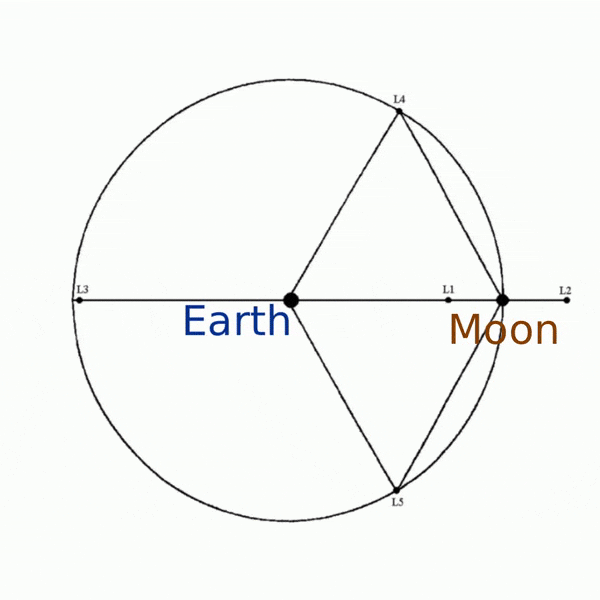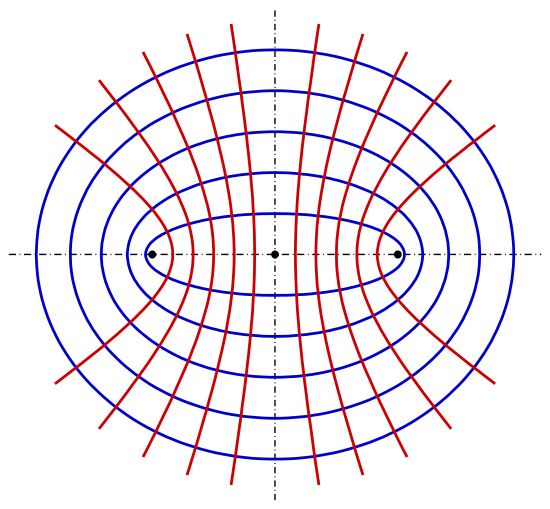Introduction
Claudio Maccone, a SETI astronomer, has proposed a system for defending Earth against small asteroids and comets. The plan calls for deflecting asteroids away from Earth with missiles launched from points of stability known as Lagrange points.
Previously, many believe that such an idea will not work. The reason being that a missile launched from the surface of the earth at the asteroid could only slow it down (barely) or break it apart.
Both would still result in the asteroid hitting the earth either as one piece or in multiple fragments.
Maccone proposes launching missiles from orbit around Earth. This allows the missiles to hit the asteroid side ways. The result is most of the missile’s momentum and/or the energy from explosive payload goes into pushing the asteroid sideways. This is more likely to successful deflect the asteroid.
Another great thing about Maccone’s idea is that it only requires Kepler’s first law to predict when and where to launch the missile.
This means that it is easy to make the system automatic. The result is that it could reduce the need for human intervention which may cost precious time.
An inevitable problem
One of the issues that concern scientists and futurists is events that could cause the extinction of the human species. Such concerns are not unreasonable.
Today for example, we face that possibility in the form of man-made climate change. Along with that, extinction could also come in other possibilities as well.
When we look at the history of our planet, we find evidence of multiple cataclysms that cause mass extinctions. These events can result in the extinction of 60% to 90% of life on Earth. Often, the group of life forms that become dominant after the extinction are not the same as the ones before.
The most well known of these is the extinction of the dinosaurs. This was when an asteroid smashed into the gulf of Mexico 66 million years ago. The same thing could happen to us humans.
The thing is, we not only need to worry about asteroids large enough to cause mass extinction. Even impacts by smaller asteroids could cause large enough effects to human society and advancement. This could also make us more vulnerable to extinction due to later events.
Unfortunately, such asteroids are harder to see. Most of them are detected when their distance from Earth is only a few times the distance from Earth to the Moon. This makes it impossible to alter the asteroid’s orbit years before it collides with Earth.
If a small asteroid was discovered while on a collision course with Earth, there would be very little time to react and plan. This is where the benefits of Claudio Maccone’s proposed system come in.
The importance of Lagrange points in deflecting asteroids away from earth with missiles
Maccone proposed a missile system placed at Lagrange points L1 and L3 in the Earth-Moon system.
These Lagrange points are regions where objects can stay stationary relative to the positions of two masses orbiting each other (in this case, the Earth and the Moon).
Lagrange points exists because of gravitational interactions between the two masses and the nature of orbital motion.
L1 is located between the Earth and Moon at a distance of 326,400 km from Earth and 58,348 km from the moon. At that distance, the moon’s gravity partially cancels out enough of Earth’s gravity making it weaker. This allows objects to orbit more slowly and stay in that position relative to the Earth and Moon.
L3 is located 381,600 km from the Earth in the opposite direction of the moon. In that location, the Moon’s gravity reinforces the Earth’s gravity. This also allows objects at that point to remain stationary even when it means orbiting faster than what would be allowed if we only have Earth’s gravity.
Maccone chose these two points as the trajectories of missiles launched from them would be easier to calculate.

Deflecting asteroids away from Earth with missiles using Kepler’s laws
As previously stated, Maccone’s system has the advantage in that it only requires Kepler’s first law and simple geometry to work.
Kepler’s first law states that every planet is in an elliptical orbit with the Sun at one of the two foci of the ellipse. The Foci are two points inside any ellipse. These are points that form a triangle with any point in the ellipse with the same perimeter as triangles between the foci and any other point on the ellipse.
For each ellipse, there are hyperbolas (or hyperbolic paths) that share the same foci as them. This is important as It turns out that hyperbolic paths and elliptical orbits that share the same focus intersect each other at right angles.

Given an asteroid on a collision course with Earth is in a hyperbolic path, it follows that there should be elliptical orbits which cross the asteroid’s path at right-angles. These orbits must also allow for Maccone’s system to launch missiles into them from missile bases in L1 and L3.
With knowledge of all those things, we have nearly everything needed to find when and where to launch the missile. This is important as we need the missile to hit the asteroid in a desired way before it hits Earth.
According to Maccone, this is simple enough such that we can easily program it into the missile system’s computer. Thus allowing for automation. This would do away with the need for human intervention which as stated previously, could cause valuable time.
Drawbacks
Like any idea, Maccone’s system for deflecting asteroids away from Earth with missiles could have certain drawbacks.
One of these drawbacks is that the system may not work on more massive asteroids. This is because more massive asteroids are harder to deflect due to their mass.
Additionally, Kepler’s laws are accurate only when all other masses are insignificant compared to the largest mass (in this case Earth). This may not be the case for larger asteroids.
Another drawback is the fact that the asteroid could pass close to the Moon while approaching Earth. When this happens, the Moon’s gravity will affect the path of the asteroid. This will make predicting it’s motion more difficult.
Finally, there is the issue that Maccone’s system is essentially a weapon in space. Therefore, building and using it would very surely cause political problems back on Earth.
Conclusion
Despite it’s drawbacks, Maccone’s idea may very well be the basis for tools that we may use in the future to aid in our survival as a species.
The hope is that we can avoid ending up like the dinosaurs for long enough. That way there will be enough time for us to become space fairing. Once that happens, it would be more difficult for humans to go extinct as we are no longer dependent on the biosphere of a single planet.
Over to you now, do you think the system discussed in this article will be effective in stopping small asteroids from hitting Earth? Do you think we should even go ahead and build such a system? Comment down below.
Also, if you like this article, please share with others and consider subscribing to our email list for alerts on new articles.
References
Automatic planetary defense Deflecting NEOs by missiles shot from L1 and L3 (Earth-Moon)